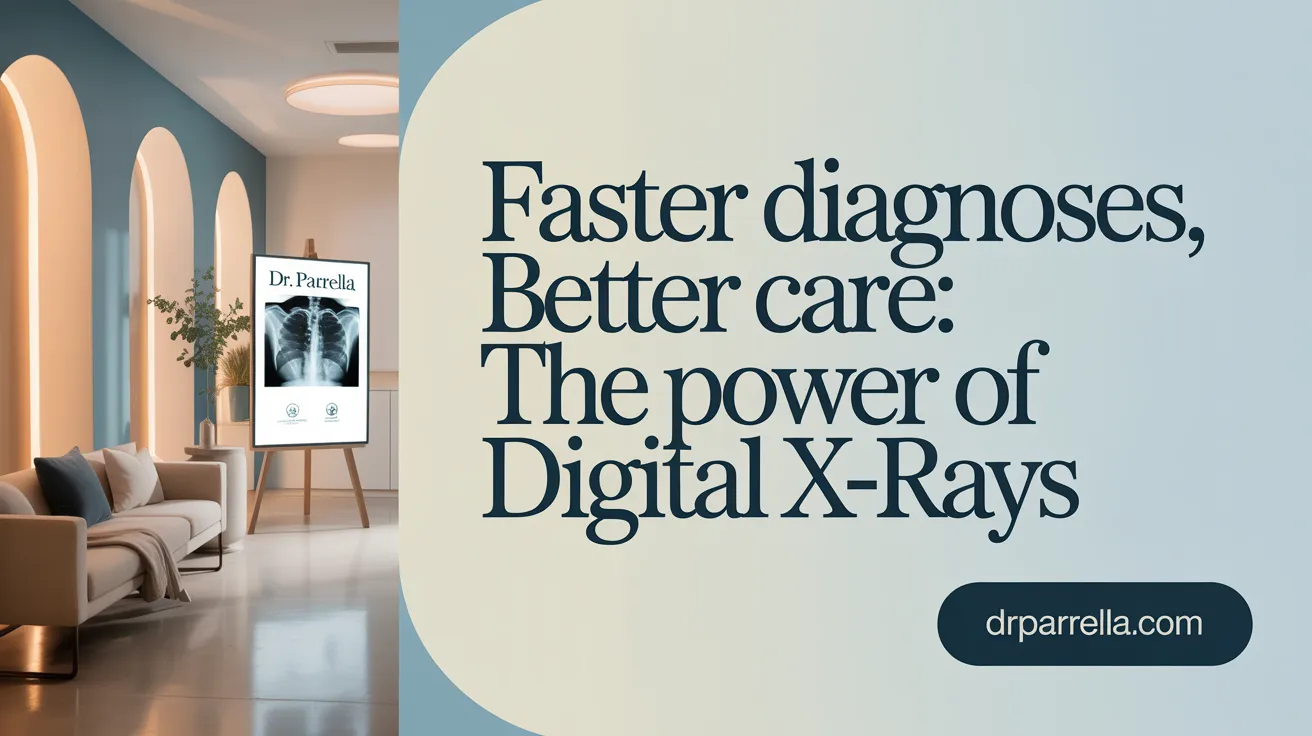Introduction to Digital X-Rays and Their Environmental Impact
Overview of digital X-ray technology in dentistry
Digital X-rays use electronic sensors instead of traditional film to capture high-resolution images of teeth and surrounding structures instantly. This technology allows dentists to view images immediately on a computer screen, speeding up diagnosis and treatment planning. Digital X-rays offer superior clarity, enabling early detection of cavities, infections, and bone loss that might not be visible during a regular examination.
Environmental benefits of digital X-rays versus traditional film
Unlike traditional film X-rays that require chemical processing, digital X-rays eliminate the need for harmful developers and fixers, reducing hazardous waste and pollution. This environmentally friendly approach also saves physical storage space since images are stored electronically and can be shared easily with other health professionals or insurance companies. By adopting digital radiography, dental practices support sustainability and lessen their ecological footprint.
Radiation safety improvements with digital X-rays
Digital X-ray technology significantly lowers radiation exposure—up to 80% less than conventional film X-rays. Modern sensors are more sensitive, requiring less radiation to produce clear images, which enhances patient safety. Because radiation doses from digital X-rays are extremely low, even vulnerable groups like children and pregnant patients are at minimal risk. Current safety guidelines often reduce or eliminate the need for lead aprons, further improving comfort and streamlining care without compromising safety.
Enhanced Patient Care and Safety with Digital Radiography

Reduction of Radiation Exposure by Up to 80%
Digital radiography represents a major advancement in reducing patient exposure to radiation during dental imaging. Compared to traditional film X-rays, digital X-rays emit up to 80% less radiation. This significant decrease enhances patient safety, making dental visits safer for individuals of all ages, including children and pregnant patients. The improved sensor sensitivity and image processing contribute to this lower exposure, aligning with modern safety standards (Modern dental X-ray technology safety, Digital radiography technology).
Instant Image Availability Speeding Diagnosis and Treatment
One of the most beneficial features of digital dental X-rays is the immediate availability of high-resolution images. Dentists no longer need to wait for film development, enabling them to quickly analyze images and discuss findings with patients during the same appointment. This streamlines the diagnostic process and facilitates faster treatment planning, reducing time spent in the dental chair and improving overall patient convenience (Instant X-ray imaging, Immediate Digital X-Ray Viewing).
Improved Image Quality Aiding Precise Detection of Dental Issues
Digital X-rays provide superior clarity and detail, with the ability to enlarge images for thorough examination. This enhancement allows dental professionals to detect minute issues such as early cavities, bone loss, infections, and other abnormalities that might be missed during a visual exam. Improved diagnostic accuracy supports timely interventions, helping to prevent more extensive procedures and preserving oral health (High-resolution dental images, Accurate Dental Diagnosis with Digital X-Rays.
Elimination of Lead Aprons Due to Modern X-Ray Safety Standards
With advances in digital radiography technology, protective gear like lead aprons and thyroid shields, once standard in dental X-rays, are now considered largely unnecessary. The American Academy of Oral and Maxillofacial Radiology recommends against their routine use, as modern equipment minimizes radiation scatter and exposure to other body areas. This change not only enhances patient comfort but also avoids obstructing image quality, which can otherwise lead to repeat X-rays (American Academy of Oral and Maxillofacial Radiology guidelines, ADA updated digital X-ray recommendations).
Dr. Anthony P. Parrella's practice in Somerville, MA, reflects a commitment to utilizing the latest digital radiography advancements to ensure patient safety and care quality. The practice offers comprehensive dental services tailored to individual needs, from preventive care to restorative and cosmetic treatments, all supported by cutting-edge diagnostic technology. Embracing digital X-rays allows them to provide efficient, effective, and environmentally conscious dental care that prioritizes patient well-being and clinical excellence (Somerville family dental practice guidelines, Digital radiography in dentistry).
Environmental Advantages of Digital X-Ray Technology in Dentistry

How does digital X-ray technology eliminate hazardous chemicals used in film development?
Digital dental X-rays do not require the use of traditional film, which must be processed with chemical developers and fixers. This elimination of chemical processing significantly reduces the release of hazardous substances into the environment. Practices adopting digital radiography, like Dr. Parrella’s in Somerville, MA, help prevent chemical pollution that would otherwise result from developing traditional X-ray films (Environmental Sustainability in Dentistry - Reducing Waste & Eco-Friendly Dental Practices, Advantages of Digital Radiography).
In what ways does digital X-ray adoption reduce chemical and physical waste?
By switching to digital sensors, dental offices avoid producing physical film, which often ends up as chemical and plastic waste. Digital images are captured electronically and do not generate the toxic waste associated with film processing. This transition not only reduces waste but also lessens the environmental burden linked to disposing of chemical containers and outdated films (Sustainable Innovations - Reducing Waste in Modern Dentistry, The Role of Digital X-Rays in Dentistry).
How does compact digital storage help decrease paper and space waste?
Digital X-rays are stored electronically, eliminating the need for bulky physical files and paper records. This compact storage keeps patient records organized and easily accessible while saving physical space in dental offices. Furthermore, electronic storage facilitates quick sharing with other healthcare providers, reducing paper use and physical mailing (Benefits of Digital Dental X-Rays.
How does the use of digital X-ray workflows contribute to lower energy consumption?
Digital workflows streamline the imaging process by providing instant results and reducing appointment times. This efficiency decreases the overall use of equipment and office resources, indirectly cutting down energy consumption. Shorter imaging and diagnostic sessions also reduce patient visits, lowering the clinic’s operational footprint (Paving the Way for a Greener, More Efficient Future with Digital Dentistry, Modern Dentistry Technology).
What role does community focus play in Dr. Parrella's dental practice?
Community focus plays a vital role in Dr. Parrella's dental practice, shaping how care is delivered. The practice actively engages with the Somerville community through oral health outreach and emphasizes patient education for better preventive care. Creating a welcoming, family-friendly environment fosters trust and long-term patient relationships, enhancing the overall health of local residents (ADA Releases Updated Recommendations to Enhance Radiography Safety in Dentistry.
| Environmental Aspect | Digital X-Ray Benefit | Impact on Dental Practice |
|---|---|---|
| Hazardous chemical elimination | No chemical film development | Reduces toxic waste, lowers pollution (Advantages of Digital Radiography |
| Reduction in physical waste | No film; electronic images | Minimizes plastic and film disposal (The Role of Digital X-Rays in Dentistry |
| Compact digital storage | Electronic image archives | Saves space, enables easy sharing (Benefits of Digital Dental X-Rays |
| Lower energy consumption | Faster imaging and workflows | Decreases resource use, shortens appointments (Modern Dentistry Technology |
Digital Imaging Streamlines Dental Practice and Patient Experience

How does faster diagnosis and treatment planning benefit patients?
Digital X-rays provide instant images that dentists can access immediately. This rapid availability allows for quicker diagnosis and timely treatment planning during the same appointment. Patients spend less time waiting for results, which enhances convenience and reduces anxiety. Learn more about the Advantages of Digital X-Rays.
How does real-time image viewing improve patient communication?
With high-resolution digital images visible on the spot, dentists can clearly demonstrate dental issues and treatment options to patients. This transparent communication helps patients understand their oral health better, making decisions more confidently and fostering trust. Discover the Role of Digital X-Rays in Dentistry.
What are the advantages of digital image sharing for referrals and collaboration?
Digital images can be easily and securely shared electronically with specialists or other healthcare providers. This seamless collaboration ensures comprehensive care and can expedite referrals, which is especially beneficial when advanced treatment or second opinions are needed. Explore the benefits of Digital Radiography in Dentistry.
How do digital records contribute to space and cost savings?
Storing digital X-rays electronically eliminates the need for physical film storage space and associated filing materials. This reduces clutter and overhead costs. Additionally, avoiding chemical processing saves resources and lowers environmental impact, reflecting a cost-efficient, sustainable approach. Read about Digital radiographs and sustainability.
How does the dental practice emphasize personalized care?
Dr. Anthony P. Parrella’s practice prioritizes personalized care by thoroughly understanding each patient’s dental history and concerns. Customized treatment plans are developed accordingly, supported by clear explanations and patient education. This individualized attention builds lasting relationships and ensures patients feel valued and confident throughout their dental experience. See the ADA updated digital X-ray recommendations for more about patient-centered care and radiography safety.
Aligning Modern Technology with Community and Environmental Responsibility

Importance of adopting updated ADA safety recommendations
The American Dental Association's recent updates emphasize reducing unnecessary radiation exposure during dental X-rays. Current Modern dental X-ray technology safety has significantly lowered radiation levels, making traditional lead aprons and thyroid collars largely outdated. These protective gears can sometimes hinder image clarity, potentially prompting repeat X-rays, which contradicts safety goals.
Reducing unnecessary radiation exposure and protective gear use
Modern digital X-rays emit up to 80% less radiation compared to film-based methods. This reduction enhances patient safety and supports efficient diagnostics. The use of rectangular collimation further limits exposure to only the area of interest, preventing needless radiation to other body parts. Hence, the minimal benefit of protective gear like lead aprons has led to recommendations against their routine use.
Community benefits of eco-friendly dental practices in Somerville
Dental practices in Somerville are adopting Digital Radiography in Dentistry, integrating digital X-rays which eliminate chemical processing waste. These efforts reduce environmental pollution and promote sustainability. Local clinics, such as those led by Dr. Anthony P. Parrella, exemplify community-oriented care by combining modern technology with green initiatives, fostering healthier environments for patients and residents alike.
How advanced digital radiography supports local health and environment goals
Advanced Advantages of Digital Radiography enables quick, high-resolution imaging with minimal radiation and no hazardous chemical use. This technology aligns with sustainability by reducing waste and energy consumption associated with traditional X-ray processing. By adopting these advancements, Somerville dental practices improve patient care quality while actively contributing to environmental preservation and community well-being.
Looking Ahead: The Future of Sustainable Dental Imaging

Emerging innovations in digital dentistry enhancing sustainability
Digital dentistry continues to advance with innovations aimed at boosting sustainability in dental care. New technologies focus on reducing patient exposure to radiation and minimizing environmental footprints through digital workflows that eliminate chemicals and paper waste associated with traditional methods.
Potential of 3D imaging and AI diagnostics to reduce waste and improve care
3D imaging in dental practices, captured via intraoral scanners, allows dentists to obtain precise three-dimensional views of teeth and gums. This accuracy aids early detection of issues, reducing the need for resource-intensive treatments. AI diagnostics in dental imaging further enhance this by interpreting images quickly and accurately, enabling timely interventions while reducing unnecessary procedures and associated waste.
Role of digital impressions and reduced disposable use
Digital impressions replace conventional molds made from alginate or polyvinyl siloxane, cutting down significant material waste. These digital scans are more comfortable for patients and reduce disposable item consumption substantially, aligning closely with green dentistry principles.
Long-term benefits of integrating green technologies in family dental practices
Incorporating digital X-rays, 3D imaging in dental practices, and eco-friendly materials fosters safer, more efficient care with less environmental impact. Family dental practices that adopt these green technologies experience streamlined appointments, better diagnostic outcomes, and contribute to overall community health and sustainability efforts. These steps also pave the way for cost savings and improved patient trust in local dental care providers.
